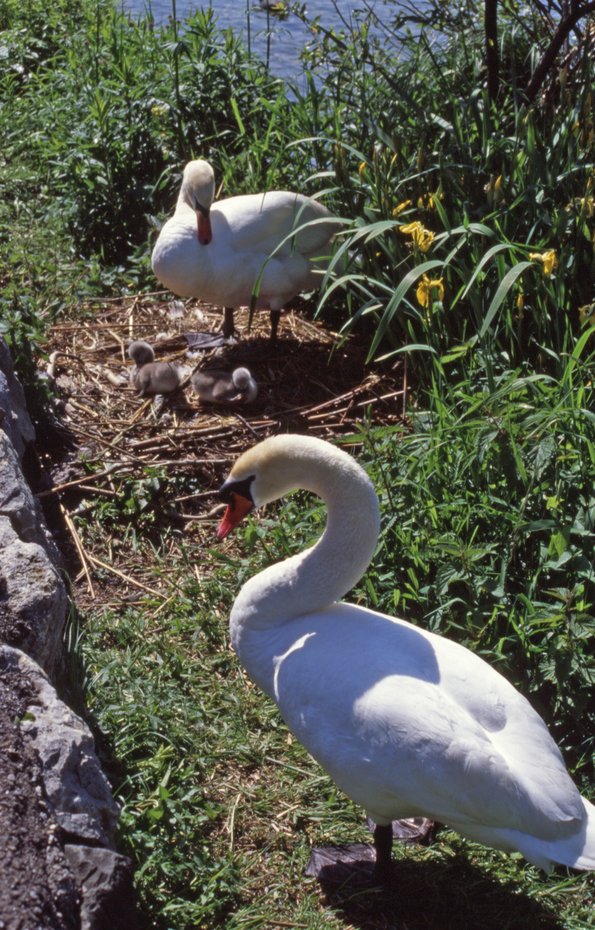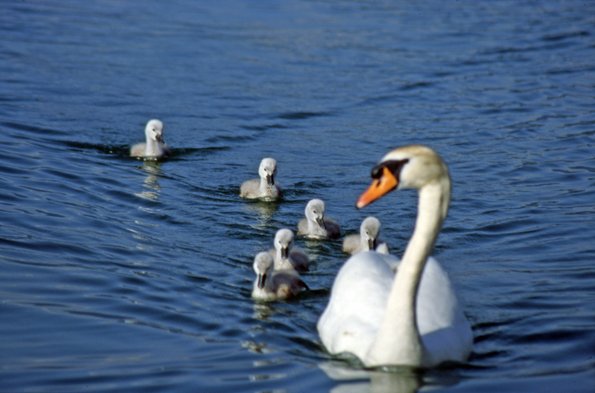Beautiful-necked paddler with white feathered vest
The mute swan – the noble goose
by Heini Hofmann
Originally the “beautiful-necked paddler” did not belong to the native avifauna. Most probably aesthetes introduced the mute swan with its graceful art nouveau look to our waters (analogous to the pink, high-legged beauty called Flamingo in the zoos). Today, the newcomer swan is assimilated and naturalised.
The swan, the noble goose
When little Hansli from a farming village visited the shores of a lake with his parents for the first time, he said in view of the swans majestically sailing along: “Look father, geese.” Whereupon the family elder corrected little Hansli with a superior smile: “Hansli, those aren’t geese, they’re swans!” The moral of the story? The little boy was also right! Because the proud beauties called swans are – from a zoological point of view and if you will pardon the expression – nothing more than high society geese.
This did not prevent Heinrich Heine from commenting zoologically and sarcastically on the fact that Zeus, the father of the gods, approached his beloved Leda unrecognized in the form of a swan and reprimanded Leda: “What a goose you have been that a swan could beguile you!” But what Heine did not consider and that which half-excuses the beautiful Leda: the seduction happened on land. What does that mean? Ferenc Molnar addresses this in the comedy "The Swan" when he postulates: “Swans should always remain majestically in the middle of the water; for they look like geese on land” ...
Naturalised and feral
The introduction of mute swans from North-eastern Europe and Asia Minor, dates to the 19th century (in England even to the 13th century). The snow-white, shapely, majestically swimming and legendary water birds first served as live ornaments on dreamy ponds in country estates, castles and cities. From here the swan found its way into sluggish watercourses; dammed river stretches and finally onto lakes.
Today, the white longneck can be found on many large and small lakes, mostly up to altitudes of 600 m above sea level, occasionally up to 1000 m above sea level, even in the Alps, when released, up to over 1700 m above sea level (as was formerly the case on the lakes of St. Moritz and Arosa). However, swans at such altitude must migrate or be trapped in winter due to icing.
In short: The swans in the whole of Central Europe are feral offspring of the park swans. While mute swans are migratory birds in the continental part of their range, they are considered sedentary and flocking birds in Europe. They do roam in spring and autumn to seek nourishment.
From semi-wild to tame
Because they have no natural enemies and are not hunted, because of an abundance of food due to eutrophication caused by civilization, because of their robustness and because people like to feed them, the beautiful long necks thrive to the extent that they present an ecological problem.
Approximately 7500 of these swimming fairy tale creatures’ grace the Swiss waters, while in the middle of the last century there were only 2000 of them. However, there are only about 650 breeding pairs among them; the rest are young animals that are not yet able to reproduce, old loners and pairs that have not been able to establish a breeding ground. The largest mute swan populations are found on Lake Constance (first released in 1917), Lake Neuchâtel and Lake Geneva (since 1837). The species calls Lake Zurich home since 1929. There are currently around 200,000 mute swans living throughout Western and Central Europe.
While semi-wild swans prefer eutrophic waters with shallow banks, lots of underwater plants, an extensive siltation zone and a wide reed belt, the tame longnecks, which are therefore dependent on humans, like to stay on populated shores, even in cities, where they are not afraid to breed in full view of everyone.
The eponymous hump
The beautifully necked paddlers glide majestically and silently over the water, like white paper ships, their tails slightly raised, their necks gracefully bent. One could almost think that the “proud” fellows know they are beautiful and graceful The snow-white plumage dominates the overall appearance of the imposing swimming birds, underlined by some striking attributes.
The orange-red beak, equipped with fine horn lamellae that allow food to be filtered out of the water, is a multi-purpose instrument that serves both for feeding and for cleaning and distributing the bristle gland secretion, even for turning eggs. At the base of the bill is a notable, black-coloured hump, which gives the animal its name; it is more pronounced in the male – especially in the breeding season – than in the female, which otherwise, with the possible exception of body size, hardly differs from the male partner.
The “reins” at the head of the white paddlers give the impression of a mask. This does not refer to the reins held in the hands of the hero of the Grail saga in Richard Wagner’s opera Lohengrin when, at the behest of King Arthur, he rushes to the aid of the harassed Duchess Elsa of Brabant in a swan-drawn yacht, but to the unfeathered parts on the side of the head, also black like the hump, called reins, which taper backwards to the nut-brown eyes.
The “immutables”
The legs and feet of the adult swans are greyish-black in colour, and the two to four toes are webbed, as is typical of all geese, and the swans belong to the same order as geese, ducks and mergansers. The juvenile plumage is brown, becoming spotty in the transition to adulthood, because the white feather base then becomes visible. For a few decades, individual swans that already exhibit pure white juvenile plumage have occasionally been observed among young semi-domesticated swans.
This is a strictly alternatively inherited mutant, caused by a recessive gene in the sex chromosome. Such animals are called “immutabilis”, or, because this gimmick of nature was first seen in Poland, “Polish swans”. Their legs and feet remain flesh-coloured throughout their lives. More details are not known. It is assumed that these “immutable” young swans are exposed to a stronger selection pressure because they do not wear a juvenile coat that would trigger more gentle treatment in older members of the species.
Animal hydrofoil
Swans, although we tend to see them mostly during the day, are diurnal as well as nocturnal. While young swans dive in case of danger, older ones do not. Fully mature swans are the alpha animals among the waterfowl, and as such it is not proper to tap the fins ...
On the contrary, they facedown danger with threatening and imposing behaviour: The attack mode or “imposing swim” is recognized by the s-shaped neck, the raised elbows with arching wings over the back like white sails, with irritated hissing and – especially impressive – with foaming bow wave. Thereby the animal hydrofoils forward jerkily, because in such “urgent cases” they row with both feet at the same time.
While they live sociably in winter, swan pairs behave territorially during the breeding season, and non-breeding beau necks form groups. Usually, the female swan begins to lay in April: five to seven or even nine large, grey-green eggs, which turn a dirty brownish-yellow in the course of incubation, which lasts 35 days. Breeding success is barely above fifty percent.
25 neck vertebrae
On land, swans rest lying or standing; in the water, they drift. When roosting, the beak is tucked under the shoulder feathers rather than under the wing. Often one leg is raised backwards. When preening, the extreme suppleness of the neck is impressive, based on the proud number of 25 vertebrae (no other bird has more).
Their cleaning ritual lasts much longer on land than in the water: tail wagging, head-neck rubbing, winging, cleaning nibbling, feather smoothing, beak dipping and flinging, head scratching and shaking, stretching shaking, feather pulling, head shaking again, wing waving – and then tail wagging again. One who wears white, cleans longer ... •
Discreet swan wedding
hh. The twinning of swans takes place without fuss. But the prelude to love, the courtship, is strictly ritualised: Head turning, beak lowering, beak jerking, mock preening, beak dipping (=mock eating), dipping (=stretching the neck above the water), snoring – and finally the affectionate posture of head touching with ruffled head feathers. Bref: courtship of swans means effort!
When Friedrich Hölderlin writes about “fair swans” “… and drunken from kisses they dip their heads into the sacred-sober water”, he describes nothing else than what scientists unromantically and realistically call “double-necked diving during copulation prelude” in a Romantic’s exuberant language.
Mating lasts a few seconds, whereby the male holds the female by the nape of her neck. After mating the male drops down sideways. A brief raising of both birds’ breast to breast is followed by the normal beak-lowering posture. Then the love-making has an end – and the preening continues. This is how the swan wedding fits into the reality of biomechanical processes …

